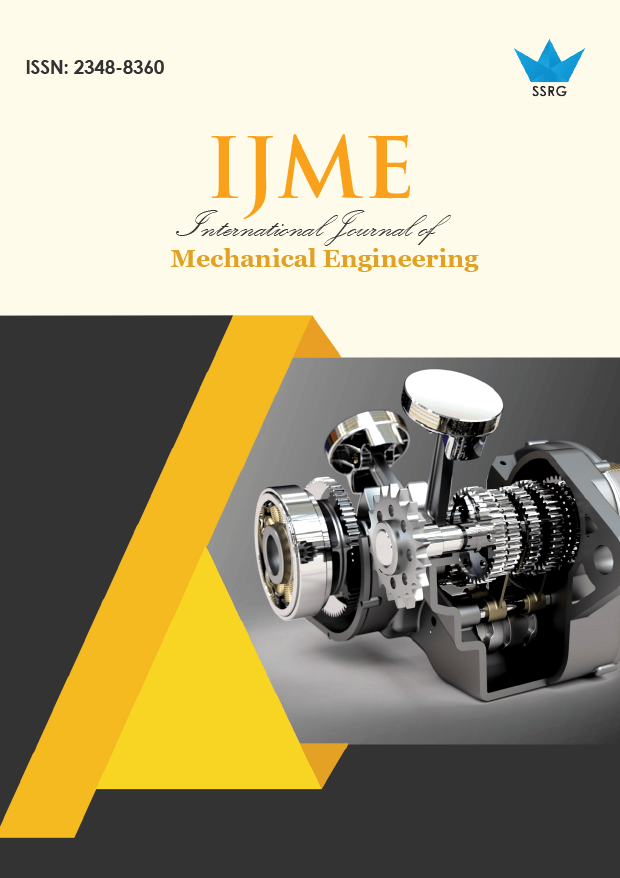Reliability Analysis of Single Point Cutting Tool on Al6063 Alloy

| International Journal of Mechanical Engineering |
| © 2024 by SSRG - IJME Journal |
| Volume 11 Issue 10 |
| Year of Publication : 2024 |
| Authors : K. Udayani, S. Gajanana, P. Laxminarayana |
How to Cite?
K. Udayani, S. Gajanana, P. Laxminarayana, "Reliability Analysis of Single Point Cutting Tool on Al6063 Alloy," SSRG International Journal of Mechanical Engineering, vol. 11, no. 10, pp. 85-95, 2024. Crossref, https://doi.org/10.14445/23488360/IJME-V11I10P108
Abstract:
This study aims to investigate the reliability of the Al6063 alloy machining of a single point cutting tool. Because of its well-known advantageous mechanical qualities, Al6063 can be used in a wide range of applications. The machining results are highly impacted by tool wear, such as flank wear, which makes prompt tool replacement necessary to preserve component quality and production efficiency. To assess tool performance, the experiment used High Speed Steel (HSS) tools under several cutting conditions, such as speed, feed, depth of cut, and rake angle. Using image processing methods, flank wear was assessed, and experimental data was used to simulate its distribution as a normal distribution. The probability that the cutting tool would function satisfactorily for the designated amount of time before needing to be replaced was ascertained using reliability analysis. The findings show that increased cutting forces improve tool reliability; in fact, some experiments had reliability percentages above 75%. The results highlight how crucial it is to maximize machining parameter optimization to extend tool life and reduce operational disturbances. To increase manufacturing productivity and quality assurance in Al6063 alloy applications, future research might concentrate on further optimizing these parameters and confirming the findings across various tool materials and machining environments.
Keywords:
DOE, Flank wear, HSS tool, Process parameters, Reliability, Resultant Force.
References:
[1] Abdalla H. Mihdy Jassim, “Effect of Heat Treatments on the Tensile Properties and Impact Toughness of 6063 Aluminium Alloy,” Al-Qadisiyah Journal of Pure Science, 2015.
[Google Scholar] [Publisher Link]
[2] Bhaskar, A. Siva, and Venkata Ramesh Mamilla, “A Reliability Based Approach for Predicting Optimal Tool Replacement Time,” International Journal of Scientific Research in Knowledge, 2013.
[Google Scholar]
[3] Carmen Elena Patiño Rodriguez, and Gilberto Francisco Martha de Souza, “Reliability Concepts Applied to Cutting Tool Change Time,” Reliability Engineering & System Safety, vol. 95, no. 8, pp. 866-873, 2013.
[CrossRef] [Google Scholar] [Publisher Link]
[4] T. I. El Wardany, and M. A. Elbestawi, “Prediction of Tool Failure Rate in Turning Hardened Steels,” The International Journal of Advanced Manufacturing Technology, vol. 13, pp. 1-16, 1997.
[CrossRef] [Google Scholar] [Publisher Link]
[5] J. G. Wager, and M. M. Barash, “Study of the Distribution of the Life of HSS Tools,” Journal of Manufacturing Science and Engineering, vol. 93, no. 4, pp. 1044-1050, 1971.
[CrossRef] [Google Scholar] [Publisher Link]
[6] K. Hitomi, N. Nakamura, and S. Inoue, “Reliability Analysis of Cutting Tools,” Journal of Manufacturing Science and Engineering vol.101, no. 2, pp. 185-190, 1979.
[CrossRef] [Google Scholar] [Publisher Link]
[7] Konstantinos Salonitis, and Athanasios Kolios, “Reliability Assessment of Cutting Tools Life Based on Advanced Approximation Methods,” Procedia CIRP, vol. 8, pp. 397-402, 2013.
[CrossRef] [Google Scholar] [Publisher Link]
[8] Won Tae Kwon, June Seuk Park, and Shinhoo Kang, “Effect of Group IV Elements on the Cutting Characteristics of Ti (C, N) Cermet Tools and Reliability Analysis,” Journal of Materials Processing Technology, vol. 166, no. 1, pp. 9–14, 2005. [CrossRef] [Google Scholar] [Publisher Link]
[9] Montasser S. Tahat, Nadim A. Emira, and Hamzeh T. Mohamad, “Study of the Mechanical Properties of Heat Treated 6063 Aluminium Alloy”, Recent Patents on Mechanical Engineering, 2010.
[Google Scholar] [Publisher Link]
[10] Nithin M Mali, and T. Mahender, “Wear Analysis of Single Point Cutting Tool with And Without Coating,” International Journal of Research in Engineering and Advanced Technology, vol. 3, no. 3, pp. 49-57, 2015.
[Google Scholar]
[11] Oussama Zerti et al., “Taguchi Design of Experiments for Optimization and Modeling of Surface Roughness When Dry Turning X210Cr12 Steel”, In Proceedings Applied Mechanics, Behavior of Materials, and Engineering Systems, pp. 275-288, 2014.
[CrossRef] [Google Scholar] [Publisher Link]
[12] Vishal S. Sharma, S. K. Sharma, and Ajay K. Sharma, “Cutting Tool Wear Estimation for Turning,” vol. 19, pp. 99-108, 2007.
[CrossRef] [Google Scholar] [Publisher Link]
[13] W.S. Lin, “The reliability analysis of cutting tools in the HSM processes”, International Scientific Journal published monthly by the World Academy of Materials and Manufacturing Engineering, vol. 30, no. 2 pp. 97-100, 2008.
[CrossRef] [Google Scholar] [Publisher Link]
[14] F.O. Edoziuno et al., “Mechanical And Microstructural Characteristics Of Almuinium 6063 Alloy/Palm Kernell Shell Composites For Lightweight Applications” Scientific African, vol. 12, 2021.
[CrossRef] [Google Scholar] [Publisher Link]

 10.14445/23488360/IJME-V11I10P108
10.14445/23488360/IJME-V11I10P108